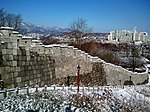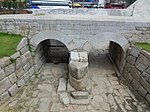Seoul City Walls
| Korean spelling | |
|---|---|
| Korean alphabet : | 한양 도성 |
| Hanja : | 漢陽 都城 |
| Revised Romanization : | Hanyangdoseong |
| McCune-Reischauer : | Hanyangtosŏng |
The walls known as the city walls of Seoul and called Hanyangdoseong ( 한양 도성 ) in Korean are remnants of the fortifications of the former city of Hanyang ( 한양 ) from the Joseon Dynasty (1392-1910).
geography
The Seoul city walls were originally 18.627 km long and were built along the ridges of the four inner-city mountains Baegaksan ( 배 각산 ), Naksan ( 낙산 ), Namsan ( 남산 ) and Inwangsan ( 인왕산 ). In addition to the partially existing city walls, eight of their city gates are still preserved, the Heunginjimun ( 흥인지문 ) as the eastern gate, the Donuimun ( 돈의문 ) as the western gate, the Sungnyemun ( 숭례문 ) as the southern gate and the Sukjeongmun ( 숙정문 ) as the northern gate, which together serve as the main gates, and the four side gates Souimun ( 소의문 ) in the southwest, Changuimun ( 창의문 ) in the northwest, Hyehwamun ( 혜화문 ) in the northeast and Gwanghuimun ( 광희문 ) in the southeast.
history
When King Taejo ( 태조 ) founded the Joseon Dynasty, he made Hanyang the capital of his empire and built city walls with city gates, bastions and mounds for signal beacons to secure and defend the city . The city walls were built in 1395 and renovated in 1421 under the rule of King Sejong ( 세종대왕 ) and made of stone. Further work and extensions to the wall took place in 1704 under the rule of King Sukjong ( 숙종 ) and most recently under the rule of King Gojong ( 고종 광무제 ) in 1869. The different construction techniques and stones used from different eras are still closed in the city walls detect.
While the Sungnyemun of the four city gates was built at the end of the 14th century, the remaining ones date from the 19th century. The mounds with the beacons were built in 1394 and were used until 1894. The walls also include five so-called water gates, called Ogansumun ( 오간 수문 ) in Korean . They were installed on the inner-city rivers flowing eastwards.
Cultural property worthy of protection
Of the original 18.627 km long city walls, a 12 km long section with a total area of 663,992 m 2 was registered by the Korean government in 1963 as a historically significant site under registration number 10. On November 23, 2012, the government had the city walls registered with UNESCO in the so-called tentative list, thereby underlining its will to have the city walls registered as a World Heritage Site .
Photo gallery
- Seoul City Walls
Web links
- World Heritage and Hanyangdoseong . Seoul Metropolitan Government,accessed November 30, 2017.




